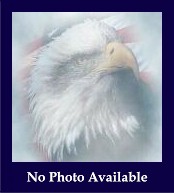The 35th Infantry Regiment Association salutes our fallen brother, PFC Ray Cornelius Richardson, who died in the service of his country on March 4th, 1945 in Luzon. The cause of death was listed as KIA. At the time of his death Ray was 28 years of age. He was from Wood County, West Virginia.
The decorations earned by PFC Ray Cornelius Richardson include: the Combat Infantryman Badge, the Bronze Star, the Purple Heart, the Asiatic-Pacific Service Medal, and the World War II Victory Medal.
Burial:
Red Hill United Methodist Church Cemetery
Red Hill
Wood County
West Virginia, USA
Ray was a farmer and was drafted/enlisted 15 July 1942.
From "Sgt Roach's Story" by Perry Ball
A BAD DAY FOR G COMPANY
Puncan, Luzon, the Philippines, 3-4 March 1945
G Company and the rest of the 2nd Battalion continued to have difficulty with the Japanese 105 mm howitzers located just west of Highway 5. The artillery pieces were located in caves set in a cliff, were heavily camouflaged, and were defended by supporting machine guns. These guns directed approximately 20 rounds of direct fire into the 2nd Battalion position in Puncan on the night of 3-4 March. Then-SSGT Sydney A. Saetre wrote that five of the shells were direct hits on his 1st Squad, 1st Platoon One round hit a tree, resulting in a tree burst over a two-man foxhole occupied by his Assistant Squad Leader, Sgt. Bruce S. Parsel, an American Indian, and his 1st Scout Pfc. Roy G. Lickenbrock. Parsel died that day. Lickenbrock was badly wounded and evacuated to the forward field hospital, but he died of his wounds three days later on 7 March. Another shell killed his BAR man, Pfc. Ray C. Richardson.ii
Japanese gunners fired most of their shells into the trees in order to create tree bursts. The tree bursts were much more deadly because they exploded overhead and rained shrapnel downward over a wide area. The men in the open had no protection from tree bursts. The men in foxholes did not have much more protection unless they had time to create overhead fortifications with logs and dirt and this was usually not the case. Consequently, the only thing they could do when tree bursts occurred was to pray for the best.
Japanese attacking parties also tried to infiltrate the perimeter, as they had attempted to do on the previous night. This time, ten Japanese soldiers were killed trying to infiltrate the perimeter. Pfc. Lang recalled that his 3rd Squad, 2nd Platoon was guarding a footbridge across a dry creek and that there was a machine gun position on his left and an anti-tank gun on his right. Sgt. Charles W. Christoph, an OCS washout who had been training soldiers in the U.S. before joining G Company and who did everything by the book, was in the same area. The Japanese soldiers fired at the G Company perimeter that night and Christoph returned fire and gave his position away. A Japanese infiltrator dropped a hand grenade into his foxhole a short while later. They picked up the pieces the next morning.
Another Japanese infiltrator got through the perimeter, was shot, and fell forward onto Lang's foxhole. Lang had a good throwing knife and he knifed the Japanese soldier as he fell. Lang did not know if the Japanese soldier was already dead when he fell or after he was knifed. Pfc. Derouen and Pfc. Sharp from the 2nd Squad, 3rd Platoon were also wounded that night. Derouen was wounded by shrapnel in the left thigh and Sharp was wounded by shrapnel in the left foot and the left thigh. They were both taken to the 43rd Field Hospital in Puncan.
Total G Company losses for the day were four dead and at least two wounded.v This was the third costliest day for G Company during the Luzon Campaign, exceeded only by the 6th and 7th of February during the Battle of Lupao.
|




